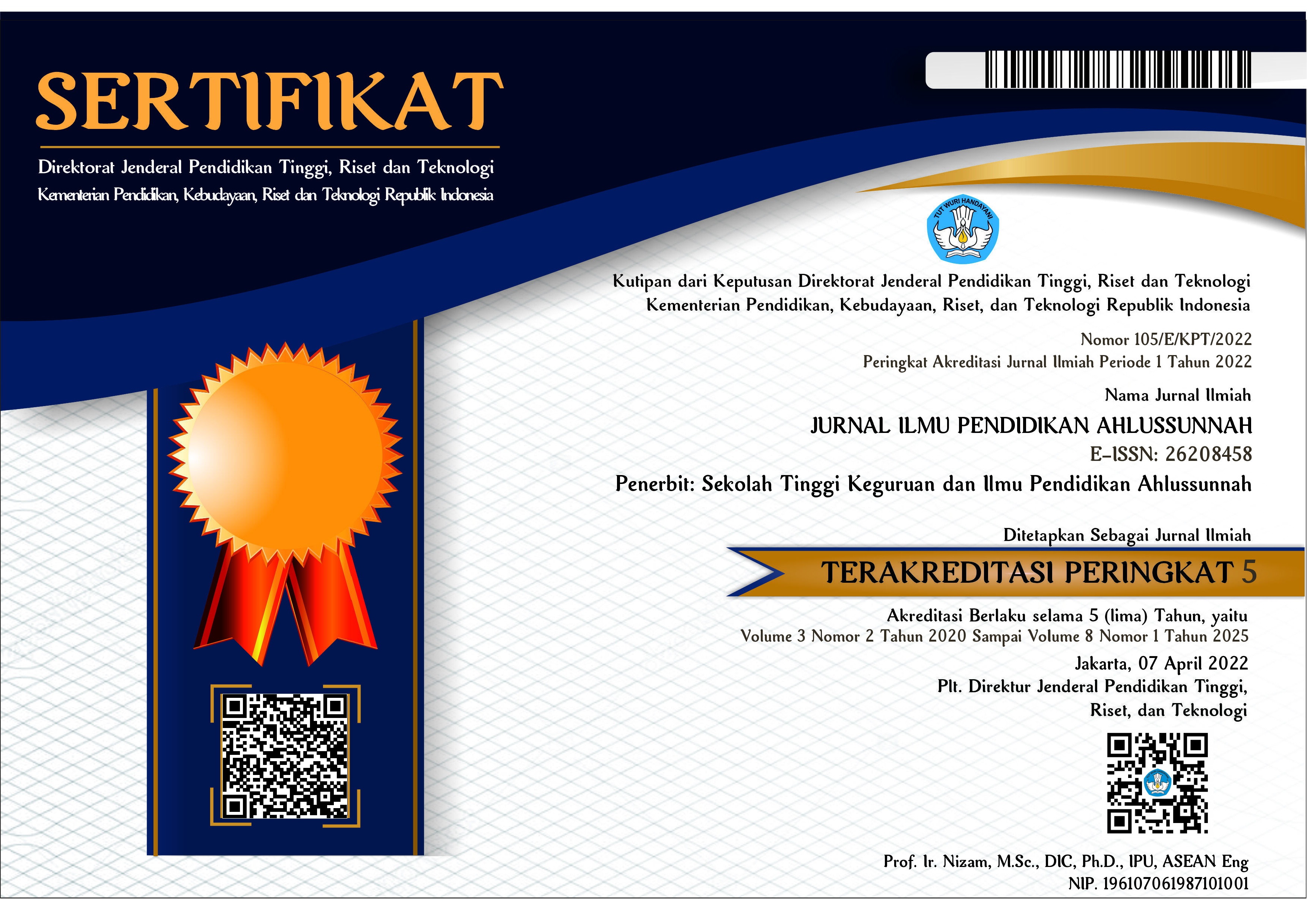JARGON VARIATIONS IN A COMMUNITY OF BEAUTY SALON WORKERS IN KECAMATAN KRONJO, BANTEN AND ITS IMPLICATIONS FOR LEARNING INDONESIAN LANGUAGE IN HIGH SCHOOL
VARIASI JARGON DALAM SUATU KOMUNITAS PEKERJA SALON KECANTIKAN DI KECAMATAN KRONJO, BANTEN DAN IMPLIKASINYA TERHADAP PEMBELAJARAN BAHASA INDONESIA DI SMA
Abstract
In the way of communicating, community contributors use a unique language in a jargon shape that is usually only understood through contributors of the community. Jargon is a variant of language that appears as the quit result of the intersection of social phenomena, social interactions, and approaches of speaking inside a community. The reason of this research is to describe the formation techniques and meanings of a number jargons in a community of splendor salon employees in Kecamatan Kronjo, Balaraja, Banten and their implications for mastering Indonesian in excessive school. Qualitative approach and descriptive technique are used in this research. Observations and documentation have been carried out in this study. Proficiency concerned commentary technique, free conversational engagement technique, recording technique, and notice taking approach have been also used to acquire data. Of the 50 statistics collected, the jargon used to be correctly recognized and classified. There are variations of the adjective jargon used in the Beauty Salon Worker Community in Kecamatan Kronjo, Balaraja, Banten, specifically 17 data, 12 records for nouns, and 11 statistics for verbs, pronouns as many as 6 data, adverbs are four data, and numerals are only 1 data. In addition, the jargon in the structure of a whole of 6 data. The consequences of this study on versions of jargon can be implicated for mastering Indonesian in excessive school, namely in primary competence 3.5, particularly writing anecdotal texts associated to the content and elements of implied meaning in anecdotal textual content material in classification X semester 1.
References
Azizah, A. R. 2019. Penggunaan bahasa Indonesia dan bahasa gaul di kalangan remaja. Jurnal Skripta, 5(2).
Chaer, A. 2007. Linguistik Umum Cetakan ke Tiga. Jakarta: Bhineka Cipta.
Chaer, A., & Agustina, L. 2010. Sosiolinguistik Perkenalan Awal. In Jakarta: Rineka Cipta.
Harianto, E. 2020. Metode bertukar gagasan dalam pembelajaran keterampilan berbicara. Didaktika: Jurnal Kependidikan, 9(4), 411–422.
Huri, D. 2017. Geografi Variasi Bahasa di Bagian Utara Karawang Jawa Barat. Jurnal Gramatika: Jurnal Penelitian Pendidikan Bahasa Dan Sastra Indonesia, 3(2), 239–248.
Inramini, I., & Jumiati, S. 2015. Jargon Bahasa Waria Suatu Kajian Pragmatik. JURNAL KONFIKS, 2(2), 133–142.
Kemdikbud. 2016. Kamus Besar Bahasa Indonesia. Kemdikbud. https://kbbi.kemdikbud.go.id/
Kridalaksana, H. 2007. Kelas kata dalam bahasa Indonesia. Gramedia Pustaka Utama.
Manshur, A. 2023. Fenomena Bahasa Slang, Bahasa Jargon, dan Bahasa Prokem dalam Komunikasi Santri Pondok Pesantren Darussalam Putri Utara Blokagung Banyuwangi. Jurnal PENEROKA: Kajian Ilmu Pendidikan Bahasa Dan Sastra Indonesia, 3(1),122–135.
Mustikasari, R., & Astuti, C. W. 2020. Pergeseran Penggunaan Bahasa Jawa pada Siswa TK dan KB di Kelurahan Beduri Ponorogo. Alinea: Jurnal Bahasa, Sastra, Dan Pengajaran, 9(1), 64–75.
Noermanzah, N. 2019. Bahasa sebagai alat komunikasi, citra pikiran, dan kepribadian. Seminar Nasional Pendidikan Bahasa Dan Sastra, 306–319.
Nurcahyo, A. 2017. Analisis Ragam Bahasa jargon yang digunakan dalam Acara Master Chef Indonesia Season 3. University of Muhammadiyah Malang.
Pakpahan, J. 2019. Jargon Komunitas Banci Salon Di Kota Medan (Kajian Sosiolinguistik). Universitas Negeri Medan.
Pertiwi, D. W. 2017. Penggunaan Jargon oleh Narapidana di Lapas Wanita Kelas IIA Medan. UNIMED.
Rahmah, N. A. 2018. Ragam Bahasa Militer Di Lembaga Pendidikan TNI AD Dan Implikasinya Terhadap Pendidikan Bahasa Indonesia.
Rukajat, A. 2018. Pendekatan penelitian kualitatif (Qualitative research approach). Deepublish.
Safitri, V. N., & Mujianto, G. 2021. Jargon Bahasa Berdasarkan Model Fungsional Speaking di Kalangan Komunitas Dakwah: Kajian Sosiolinguistik. Madah: Jurnal Bahasa Dan Sastra, 12(2), 207–222.
Satyaninrum, I. R., Tahirs, J. P., SE, M. M., Bhaga, B. J., Kpalet, P., Agustikawati, N., Aisyah, S., & SH I, M. H. 2022. Metodologi Penelitian. Cendekia Publisher.
Setiawan, F. 2018. Fungsi Instrumental pada jargon komunitas kru bus jurusan Jember-banyuwangi. KEMBARA: Jurnal Keilmuan Bahasa, Sastra, Dan Pengajarannya, 4(1).
Setiawati, E., & Arista, H. D. 2018. Piranti pemahaman komunikasi dalam wacana interaksional: Kajian pragmatik. Universitas Brawijaya Press.
Sri Maihendriani, S. M. 2015. Bentuk dan Makna Jargon Para Pedagang di Pakan Rabaa Kecamatan Baso Kabupaten Agam. Universitas Negeri Padang.
Triwicaksono, M. D., Triana, L., & Sari, V. I. 2020. Jargon Pengemudi Gojek Brebes Tegal Slawi dan Implikasinya Terhadap Pembelajaran Bahasa Indonesia Di SMA. Jurnal Ilmiah Wahana Pendidikan, 6(3), 275–285.
















